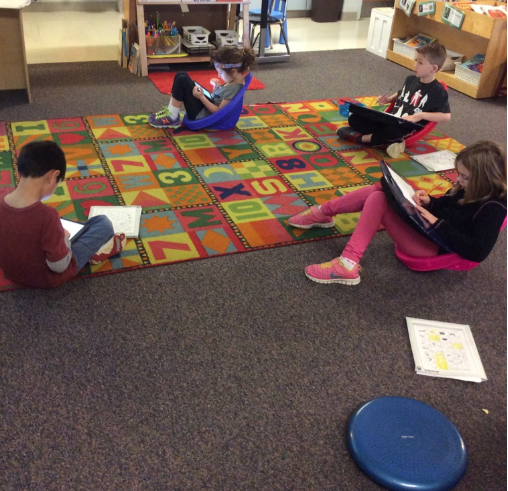
Everyone is a writer, everyone has a story to tell. Sometimes we hit challenges in the process. Maybe it’s the act of sitting down to write as Stacey shared in her post, Writing Victories, or maybe writing is challenged by fine motor skills that need to be refined. In this post, I will share with you tools and modifications to help writers overcome the fine motor skills that can halt writing. Writing is about message sharing and communication and while fine motor strength is only a small part of sharing our message, it can be paralyzing for some students.
If it’s the fine motor skills that need to be developed, consider a few of these fine motor exercises and modifications. Your budding writers might not even recognize them as a precursor to writing, but they will thank you!
Tummy Time:
Remember the tummy time we were encouraged to give our babies? Well, it’s not over. In my years as a special education teacher, I worked with many occupational therapists (OT). The OTs suggested I allow students to lay on their tummies, propped on their elbows to write or practice other fine motor tasks. This position allows students to have more control over their fine motor skills. This is an alternative seating practice my kids use every day.
Inclined Surfaces:
Lap boards, easels, and slant boards all provide writers with a surface that flexes the wrist back and gives greater fine motor control to the writer. With the wrist flexed back, the hand naturally falls into position to promote a more accurate tripod grasp. The angle also provides a better visual for the student with visual impairments.
Lap Desk:
Whether it is laying out on the floor or sitting criss-crossed on the floor, the writers in our room enjoy the variety of using a lapboard to steady paper or iPads as they write their stories. Lapboards bring the work a bit closer to the writer and can provide an inclined surface, again aiding an opportunity to develop fine motor skills.
Bean Bags and Scoop Seats:
Both bean bags and scoop chairs provide feedback as they envelop the body making the writer feel secure and steady. Add a clipboard, lap board, or an inclined surface to help the writer feel comfortable and ready to write.

Find the Right Writing Tool:
We all have a favorite pen or stylus, and I have learned small golf or library pencils or a mini sharpie can be just the right size for small hands. The short size of the pencil allows more control and encourages a better tripod grasp. Consider adding a few to your games for keeping score, the pencil trays in the office, and the writing area.
Weighted pencils are another tool I have found to help motor planning and provide more feedback to students with balance and proprioceptive awareness. Adding weight to the end of a writing utensil ( can also be done as home using nuts, bolts, and rubber bands) also promotes a tripod grip by pushing the pen back into the web space between the thumb and index finger. Vibrating pens are another a big hit. Their size is a bit larger than a typical pen, making it easier to grasp for some writers. They are battery operated which adds a nice weight. When the pen is turned on it wriggles as it makes squiggly lines and provides a high vibration in the hand of the writer.
Get Appy:
Get to the valuable business of creating a message without the struggle of fine motor. Explore apps that allow students to record audio, draw, write with a stylus (or a finger), or type. Pixie, Explain Eveything, and Noteability are few popular apps that meet all these needs and are easily mastered by young writers. If fine motor is the obstacle for your writer, versatile apps may be just what you need to support your writer and their stories.
Whatever the writing tool, iPads, computers, pens, pencils, or markers of any size and type, be flexible and allow the writer to explore the options available. What works for one writer may not be what works for another writer.
Keeping it Fun:
 Instructional drawing books like those by illustrator artist Ed Emberley and Steve Harpster provide an irresistible invitation to grab pencil and paper. What better way to develop fine motor skills?
Instructional drawing books like those by illustrator artist Ed Emberley and Steve Harpster provide an irresistible invitation to grab pencil and paper. What better way to develop fine motor skills?
Games like Perfection, stringing beads, legos, molding clay, stencils, and Spirograph can be another fun way to strengthen fine motor skills. If you’re looking for more game-like ideas, Google “fine motor skills” and get ready to start pinning, bookmarking, or noting all the easy and fun ideas; there are a million.
*****

GIVEAWAY INFORMATION:
- This giveaway is for a copy of Joy Write: Cultivating High-Impact, Low-Stakes Writing. Many thanks to Heinemann for donating a copy for one reader. (You must have a U.S. mailing address to win a copy of this book.)
- For a chance to win this copy of Joy Write: Cultivating High-Impact, Low-Stakes Writing, please leave a comment about this or any blog post in this blog series by Sunday, May 7th at 12:00 p.m. EDT. Betsy Hubbard will use a random number generator to pick the winners whose name will be announced in the ICYMI blog post for this series on Monday, May 8th.
- Please be sure to leave a valid e-mail address when you post your comment, so Betsy can contact you to obtain your mailing address if you win. From there, our contact at Heinemann will ship your book out to you. (NOTE: Your e-mail address will not be published online if you leave it in the e-mail field only.)
- If you are the winner of the book, Betsy will email you with the subject line of TWO WRITING TEACHERS – JOY WRITE BOOK. Please respond to her e-mail with your mailing address within five days of receipt. Unfortunately, a new winner will be chosen if a response isn’t received within five days of the giveaway announcement.


Is there a twitter hashtag that students could share it?
LikeLike
Thanks for so many great ideas.
LikeLike
This piece is going to help so many people, Deb. I wish I had had something like this as a resource when I was teaching in the classroom. There were so many kids who could’ve benefitted from the things you wrote about above. Alas, this piece is here now and I plan to share it again and again any time I hear of a child who is having trouble with the physical act of writing.
BTW: Where can I buy weighted pencils?
LikeLike
Never knew about ‘tummy time’ for writing. I see students prefer this for reading when given a choice.
I’m not crazy about bean bags as a seating option. I like the look of the plastic chairs in the photo. Will have to look for those!
LikeLike
Great ideas!
LikeLike
I’m enjoying all the posts in this series. Thanks!
LikeLike
re writing
On Wed, May 3, 2017 at 11:09 PM, TWO WRITING TEACHERS wrote:
> Deb Frazier posted: ” Over the school year, I work each day to sow the > seeds that will turn out students who write. Students who write because > they see value and power in writing. Cultivating writers who work with > purpose and intention doesn’t happen in one lesson, one uni” >
LikeLike
This post is perfect for one of my students who struggles with steadily holding his pencil. I am going to share this post with his mom. Thanks!
LikeLike
I found this entry to be interesting and helpful. Teaching fifth grade language arts, I encourage and expect a great deal of writing. I now have some new ways to encourage students who find it more challenging.
LikeLike
As an elementary literacy coach, I am often asked about reluctant writers, namely those who struggle with fine (or even large!) motor skills. This blog post is a keeper. Awesome ideas! Thank you!
LikeLike
I didn’t even know there was such a thing as a vibrating pen. I’m going to have to check into that. I love having all these suggestions for students to get around fine motor skills challenges. I had not thought of using lapboards in the classroom, but it makes so much sense. Great addition to a great series of solutions for continuing writing for the summer.
LikeLike
love Ralph Fletcher
great ideas for alternatives for writers
LikeLike
Great ideas for writing tools and flexible seating.
LikeLike
This blog series has many great ideas. Some to share with staff and some to share with parents. Thank you!
LikeLike
wonderful to see these ideas on your writing blog! Teachers who build an environment where kids do things differently to thrive as writers will love these! Can’t wait to share!
LikeLike
More great ideas! I am loving this series! Such helpful tips!
LikeLike
Thanks so much for this post full of great ideas. I am presenting a talk on summer literacy (not just summer reading, but writing too) and will share some of your ideas! Of course, I will give credit to you! Thanks for always inspiring my work!
LikeLike
Great suggestions! I can’t wait to get this book! If I win a copy great, if not, I am definitely buying it!
LikeLike
Our school really wants to focus on handwriting next year. I love these strategies!
LikeLike
This post gives a great variety of ideas to try with students, thus providing choice and positive outcomes for our young writers. I’d never heard that laying on your stomach improves stability for fine motor, but it makes perfect sense. Thanks so much for sharing these ideas.
LikeLike
This post took me back to my kindergarten teaching days! Kids loved the Play-Doh center!
Although this was math-focused, I had them pick up mini marshmallows (counting activity) with tweezers for fine motor development.
Still hoping to win JoyWrite!!
LikeLike
Great fine motor ideas. I have been doing more purposeful fine motor fun activities this year and it sure makes a difference for my preK students.
LikeLike
This is a great post with so many ideas! I have a tried a few of those and am always amazed at how well they work. This year a student came up with the craziest idea, but it works for several of them. I have an empty Rubbermaid bin the room ( I moved rooms over the summer and it was still hanging around under a table at the beginning of the year.) Sometimes kids like to scrunch up inside of it and read. They also like to lay it on it’s side and tuck their head inside…like a cubby. They lay on their stomachs and work on a clipboard. It muffles the sounds come in, and also muffles the sounds the child might be producing. I now have two of these bins available for student use.
LikeLike
I love these ideas! I would also suggest the stand up desk! This gave students another option and seemed to help with the squirmies
LikeLike